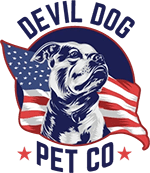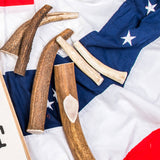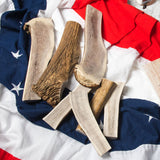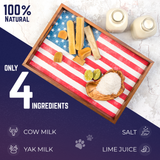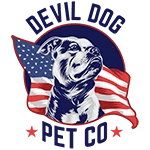You've probably seen those massive, paddle-shaped antlers mounted in hunting lodges and wondered: could those work as dog chews? Moose antler chews are gaining serious traction among dog owners who want something tougher than rawhide but gentler than synthetic bones. These naturally shed antlers offer a unique middle ground-softer than elk antlers yet still packed with minerals and lasting power.
Key Takeaways
- Moose antler chews are becoming popular as durable dog chews that are tougher than rawhide.
- These chews provide a natural alternative that is gentler than synthetic bones.
- Moose antlers are softer than elk antlers but still rich in minerals and long-lasting.
- They are sourced from naturally shed antlers, making them a sustainable choice.
Table of Contents
Here's the reality: moose antlers aren't just oversized elk antlers. Their distinctive paddle shape and softer bone density create different chewing experiences, and that matters when you're sizing up safety and durability for your dog. While some veterinarians raise concerns about any hard chew, others recognize that supervised antler chewing can support dental health when matched correctly to your dog's size and chewing style.
The big question isn't whether moose antlers for dogs are universally safe-it's whether they're right for your dog. That depends on factors like jaw strength, dental health, and your commitment to supervision and proper sizing.
Quick Answer
Moose antler chews are naturally shed antlers that provide a softer alternative to elk antlers while still delivering mineral-rich, long-lasting chewing satisfaction. They're generally safer for moderate chewers than harder antler varieties, but require proper sizing (larger than your dog's mouth), supervision, and aren't recommended for puppies, seniors with dental issues, or dogs who bite straight down with excessive force. When sourced ethically and matched correctly, they offer excellent dental benefits and mental stimulation.
What Are Moose Antler Dog Chews?
Moose antler dog chews are sections of naturally shed moose antlers, harvested each spring when bull moose drop their racks as part of their annual growth cycle. Unlike horns, which are permanent keratin structures, moose antlers are living bone that regenerates yearly-making them a completely renewable resource.
The anatomy matters for chew selection. Moose antlers feature distinctive broad "paddles" at the tips, cylindrical "beams" along the main shaft, and multiple "tines" or points branching outward. Each section offers different chewing experiences:
- Paddles: Flat, wide sections ideal for large dogs or multi-dog households
- Beams: Dense, cylindrical portions that provide the longest-lasting chew
- Tines: Smaller branches perfect for medium-sized dogs
- Bases: Thickest sections with porous texture from natural shedding
What sets moose antlers apart from elk or deer varieties is their softer bone density and higher moisture content when fresh. This translates to a chew that's tough enough to last weeks but forgiving enough to reduce tooth fracture risks compared to ultra-hard elk antlers. The mineral profile remains impressive-natural calcium, phosphorus, and trace minerals that support bone health.
Key Point: Moose antlers are shed naturally every spring, so no animals are harmed in harvesting. However, not all moose horn for sale comes from ethical sources-always verify that antlers are collected from natural sheds, not farmed or hunted animals.
Sourcing & Ethical Practices

Understanding where your moose antler dog chew comes from isn't just about quality-it's about supporting sustainable practices that protect wildlife populations. Every spring, bull moose naturally shed their antlers as testosterone levels drop, triggering a biological process that causes the antler to separate cleanly from the skull. This creates a renewable resource that requires zero harm to the animal.
Ethical antler collection happens in specific regions where moose populations are healthy and regulated. Prime collection areas include:
- Maine: Dense moose populations in northern forests provide consistent shed availability
- Wyoming & Montana: Western ranges offer high-quality antlers from well-nourished herds
- Alaska: Massive bull moose produce the largest, most durable antlers available
- Canadian Provinces: Sustainable collection programs support both wildlife management and local economies
Professional shed hunters use trained dogs to locate dropped antlers in dense forest areas where manual searching would be nearly impossible. These dogs can detect the mineral scent of fresh antlers from hundreds of yards away, making collection efficient while minimizing ecosystem disruption.
Red Flags to Avoid: Antlers that are sawn off (you'll see cut marks), antlers with skull fragments attached, or suspiciously cheap large moose antlers often come from questionable sources. Legitimate shed antlers show natural separation points where the antler detached cleanly.
The sustainability factor is compelling. A single bull moose can produce 40-60 pounds of antler annually, and these antlers biodegrade completely if left in the forest. By collecting and processing them into dog chews, we're creating value from a renewable resource while supporting wildlife conservation funding through collection permits and fees.
Types, Cuts, and Sizing
Not all moose antler chews for dogs are created equal. The section of antler, how it's cut, and the sizing directly impact safety, durability, and your dog's chewing experience. Here's how to navigate the options:
Whole Moose Antlers
Complete antler sections that showcase the natural paddle shape. These massive chews work best for large breed dogs (80+ pounds) or multi-dog households where several dogs can share safely. Expect 2-6 months of chewing depending on your dog's intensity.
Moose Paddle Sections
The flat, broad tips of moose antlers that provide maximum surface area for chewing. Moose paddle for dogs offers the gentlest introduction to antler chewing since the flatter surface distributes bite pressure better than cylindrical sections.
Beam and Tine Cuts
Cylindrical sections from the main antler shaft provide the most concentrated chewing. Beams suit power chewers who need serious jaw engagement, while individual tines work perfectly for medium breeds (30-60 pounds).
Split Moose Antlers
Antlers cut lengthwise to expose the inner marrow, similar to split elk antlers but with softer bone density. These provide immediate flavor reward and work well for dogs transitioning from softer chews.
Pros
- Softer than elk antlers, reducing tooth fracture risk
- Natural mineral content supports bone health
- Paddle sections distribute chewing pressure evenly
- Completely renewable and biodegradable resource
Cons
- Still hard enough to potentially damage teeth in aggressive chewers
- Limited availability compared to deer or elk antlers
- Higher cost due to collection difficulty and size
- Not suitable for puppies or senior dogs with dental issues
Sizing remains critical for safety. Choose an antler section that's longer than your dog's muzzle and too thick to fit between their back molars. A 50-pound dog needs at least a 6-inch section, while giant breeds require 10+ inch pieces to prevent swallowing hazards.
Buying Guide & What to Expect

Finding legitimate moose horn for sale requires knowing where to look and what red flags to avoid. The moose antler market operates differently than mass-produced dog chews-availability fluctuates seasonally, and quality varies dramatically between suppliers.
Specialty Online Retailers
Dedicated antler chew companies offer the most reliable sourcing and quality control. These businesses typically work directly with licensed shed hunters and provide detailed origin information. Expect to pay $15-25 for medium sections, $35-60 for large moose antlers, with whole paddles reaching $80-120 depending on size.
Mainstream Pet Retailers
Major chains occasionally stock moose antler products, but selection remains limited and inconsistent. Online marketplaces carry various brands, though quality control can be hit-or-miss without careful vetting of seller credentials.
Quality Indicators: Look for suppliers who specify collection regions, provide shed certification, and offer detailed sizing guides. Avoid suspiciously cheap options or sellers who can't answer basic questions about sourcing.
Shipping policies matter significantly due to the weight and bulk of moose antler dog chew products. Most specialty retailers offer free shipping on orders over $50-75, with expedited options for urgent needs. International shipping remains limited due to agricultural import restrictions in many countries.
Price comparison reveals interesting patterns. While moose antlers cost more upfront than elk or deer alternatives, the cost-per-chewing-hour often works out favorably for large dogs. A $40 moose paddle that entertains your dog for three months beats buying $60 worth of bully sticks monthly.
Safety Considerations & Veterinary Perspective
The veterinary community remains divided on hard antler chews, with valid concerns about dental fractures balanced against the benefits of natural, long-lasting enrichment. Understanding both sides helps you make an informed decision for your specific dog.
Dental fractures represent the primary risk with any hard chew, including moose antler chews for dogs. However, moose antlers are generally softer than elk antlers due to their faster growth rate and different mineral composition. This softer density reduces-but doesn't eliminate-tooth fracture risk compared to harder alternatives.
Benefits Veterinarians Acknowledge
- Natural abrasive action helps control tartar buildup
- Single-ingredient composition eliminates additive concerns
- Long-lasting nature reduces frequent treat purchasing
- Mental stimulation benefits for anxious or bored dogs
Veterinary Concerns
- Potential for tooth fractures, especially in aggressive chewers
- Choking hazard if pieces break off or become too small
- Not suitable for puppies, seniors, or dogs with existing dental issues
- Individual variation in chewing style affects safety
The key lies in proper supervision and individual assessment. Dogs who gnaw methodically along the surface typically handle antlers well, while those who attack chews with full bite force face higher risks. Watch your dog's chewing style during the first few sessions to gauge compatibility.
Alternative options exist for dogs who don't suit hard antler chews. Softer alternatives like yak chews, thick bully sticks, or frozen Kong toys provide similar mental stimulation with reduced dental risk. The goal remains the same: appropriate enrichment that matches your dog's individual needs and chewing patterns. For a deeper dive into the pros and cons, check out this blog on whether antlers for dogs are a good idea or review this external resource comparing moose and elk antler chews.
Making the Right Choice for Your Dog

Moose antler chews for dogs represent a natural, sustainable option that works exceptionally well for the right candidates. Large, healthy adult dogs with methodical chewing styles often thrive with these long-lasting chews, while aggressive chompers or dogs with dental sensitivities need gentler alternatives.
The sustainability factor sets moose antlers apart from synthetic options. Every chew represents a completely renewable resource that supports wildlife conservation funding and local economies in moose habitat regions. When sourced ethically, these chews align with environmentally conscious pet ownership.
Success comes down to honest assessment of your dog's chewing style, dental health, and supervision availability. Start with a smaller section to gauge compatibility before investing in larger pieces. Monitor early sessions closely, and don't hesitate to switch to softer alternatives if your dog shows signs of aggressive chewing or dental discomfort.
Remember that no single chew works for every dog. The best approach often involves rotation between different textures and hardness levels to provide variety while maintaining safety. Whether you choose moose antlers or alternative options, the goal remains consistent: providing appropriate mental stimulation and dental benefits through supervised, size-appropriate chewing opportunities. For more on the differences between antler types, see this comprehensive comparison of deer antler vs elk antler for dogs.
Download the FREE 10-Step Dog Prep Guide
Frequently Asked Questions
What's so special about moose antlers?
Moose antlers are some of the largest and heaviest found in the deer family, prized for their unique broad, palm-like shape. Their size and structure make them durable chews that provide substantial dental exercise and mental stimulation for dogs, though their thickness demands careful supervision to prevent tooth damage.
How much is a moose antler worth?
The value of a moose antler varies depending on size, quality, and sourcing, often ranging from $50 to several hundred dollars for large, intact pieces. Natural shed antlers collected responsibly from the wild hold the most value due to their rarity and ethical sourcing.
Why do moose antlers pop off?
Moose shed their antlers annually as part of a natural cycle triggered by hormonal changes after the mating season. This process allows them to conserve energy during winter and regrow larger antlers the following year for breeding displays and dominance.
Why do vets not recommend antlers?
Some vets caution against antler chews because their extreme hardness can cause cracked or broken teeth, especially in aggressive chewers. Additionally, sharp edges or splinters can pose choking or mouth injury risks if the chew is not properly sized or supervised.
Is it painful for moose to shed antlers?
Shedding antlers is a natural and generally painless process for moose. The antlers detach at a specialized junction called the pedicle, where bone resorption weakens the connection, allowing the antler to fall off without causing discomfort.
Do moose drop antlers every year?
Yes, moose typically shed their antlers annually, usually in late winter or early spring, to prepare for regrowth in the upcoming season. This yearly cycle supports their reproductive strategy and overall health.
